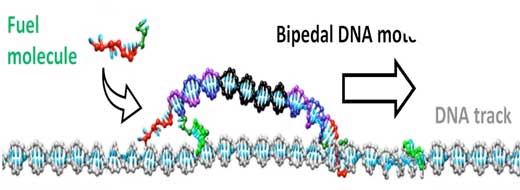| Posted: Jan 25, 2018 |
Track-walking molecular motors
(Nanowerk News) Molecular cargo transportation is an ongoing and vital undertaking in every cell of the human body. However, Nature does not use wheeled vehicles to perform this task. Instead, Nature transports intracellular cargos using bipedal molecular motors that walk along a mesh of molecular filaments called cytoskeletons. By mimicking Nature, the development of artificial track-walking molecular motors (nanowalkers), can potentially open up a wide range of nanoscale applications.
|
|
Prof WANG Zhisong and his research team from the Department of Physics, NUS have developed two sets of conceptually new mechanisms that enable artificial nanowalkers to move in a self-guided direction using their internal mechanics (Nanoscale, "A DNA bipedal nanowalker with a piston-like expulsion stroke").
|
 |
| Illustration of an autonomous DNA bipedal motor that is powered by chemical fuels for self-directed “hand-over-hand” walking (similar to how a human walks, two legs alternately leading each other) along a filament track (made of DNA). The motor has two identical legs which have two “forks” each (marked in red and green). (Image: NUS)
|
|
Presently, most artificial nanowalkers must damage the traversed part of the track when they proceed in a given direction. This often occurs through a chemical reaction catalysed or initiated by the artificial nanowalker to remove a molecular part of the traversed track, which is made of DNA. This “bridge-burning” strategy blocks the backward motion of an artificial nanowalker so that it keeps moving forward like a domino cascade, rendering the traversed part of the track unusable.
|
|
The mechanisms which the team have developed allow for the construction of different types of nanowalkers that can be tuned in terms of their movement direction, walking gait and performance.
|
|
The molecular motors developed by the research team are biomimetic bipeds made of engineered DNA molecules. These molecular motors can be powered either by chemical fuels (in which the motor catalyses a chemical reaction involving the fuel molecule and uses the released energy) or through light illumination. They produce translational motion if the track, which is formed via DNA assembly, is linear and rotational motion if the track forms a circle.
|
|
Thus these “non-bridge-burning” molecular motors can function as a transporter or a rotor at the molecular level, depending on the track configuration. In contrast, a “bridge-burning” molecular motor on a circular track falls into forward or backward rotation randomly and is incapable of repetitive operation.
|
|
Prof Wang said, “These new molecular motors can open up new nanoscale applications beyond those which can be achieved by state-of-the-art “bridge-burning” type motors. With optically or chemically-powered DNA motors, we can potentially realise biomaterials that can adapt their shape according to their environment (like an octopus). These biomaterials can be made from elastic fibres that embed molecular motors, exhibiting fine motion control that is similar to our muscles.”
|

